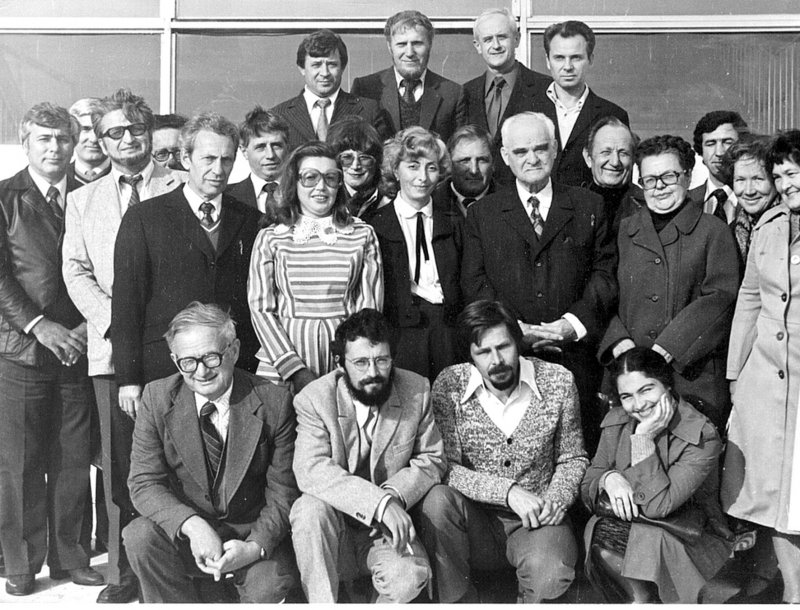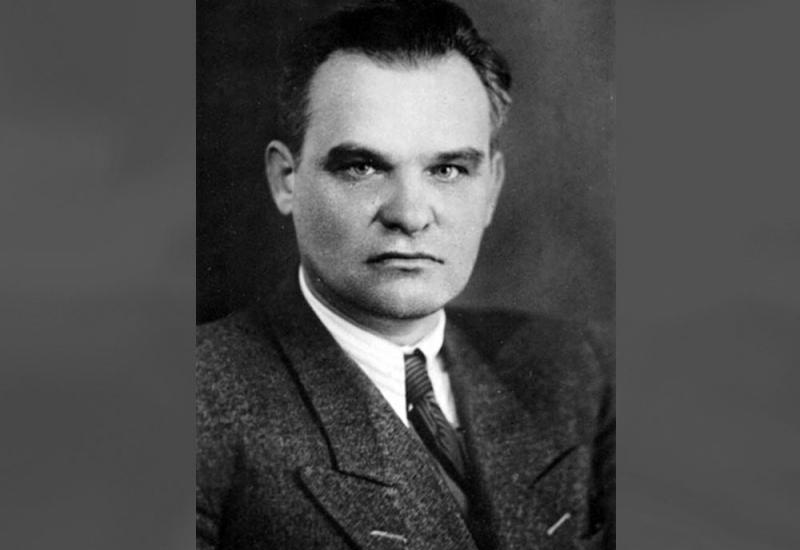Probably a lot of the graduates of Igor Sikorsky Kyiv Polytechnic Institute remember that from the 60s to 90s of the 20th century one of the basic textbooks on physics that they used while preparing for admission to the institute was the " Handbook on Physics for University Entrants" edited by Professor M.P. Kalabukhov. Capsulized and easy to understand, and at the same time, correct from a scientific point of view explanations of the most difficult questions for high school students made it very popular among applicants at the time.
However, Mykola Petrovych Kalabukhov was not only a talented teacher and a good methodologist, but also a famous researcher. From 1956 to 1972, he headed the Department of General Physics at Kyiv Polytechnic Institute.
October 20, 2022 marked the 120th anniversary of his birth.
M.P. Kalabukhov was born in the family of a power plant manager in the city of Rostov-on-Don in 1902. In 1920, he graduated from the Alexander Gymnasium in the city of Tsaritsyn (now Volgograd), and studied at the Tikhoretsk Commercial School. In 1925, he entered the physics department of the Faculty of Physics and Mathematics at Tomsk University.
After graduating from the university in 1930, M.P. Kalabukhov worked at the Institute of Applied Physics, and then at the Siberian Physical-Technical Institute (SFTI), which was opened in 1930 at Tomsk University. At that time, a group of physicists from the Leningrad Physicotechnical Institute headed by Prof. P.S. Tartakovskyi (1895-1940) was invited to the SFTI. M. P. Kalabukhov began his scientific activity under Professor P. S. Tartakovskyi’s supervision. It should be noted that in the 1920s, Prof. P.S. Tartakovskyi was an assistant at the Department of Physics of Kyiv Polytechnic Institute, which at that time was headed by Professor O.H. Goldman (1884-1971).
M.P. Kalabukhov together with P.S. Tartakovskyi discovered the phenomenon of electronic polarization of colored alkali-halide crystals at the Siberian Physical-Technical Institute. This phenomenon became the basis of modern electrophotography. In addition, he performed a number of works related to the study of the photo effect at the interface between a metal and a dielectric.

In 1935, M.P. Kalabukhov defended his candidate's thesis on the topic "On the internal photo effect in alkali-halide crystals" and obtained the degree of a candidate of physical and mathematical sciences. As an associate professor at Tomsk University, he taught several courses in theoretical physics.
In 1937, Mykola Petrovych married M.O. Melik-Babakhanova, a pianist at the Tbilisi Conservatory, moved to Tbilisi, where he worked as an associate professor at the Department of Experimental Physics of the Tbilisi State University. He headed this department in 1940. In 1941, the Institute of Physics of the Academy of Sciences of the Georgian SSR was organized in Georgia under the leadership of E.L. Andronikashvili, where M.P. Kalabukhov became the head of the department of experimental physics, and later - the head of the department of solid state physics.
In Tbilisi, M.P. Kalabukhov developed a prospect in the study of electrical and optical properties of rigid bodies, in particular, photoelectric properties of alkali-halide crystals. He proposed an original method of determining the point defect clusterization in crystals under the action of hard radiation - the method of repeated radiation followed by measurement of the photocurrent. Subsequently, this method was widely used both in the USSR and abroad. The study of quasi-metallic particles formed during the radiation of crystals held a high position in M.P. Kalabukhov's research. He also studied relaxation phenomena in mirrored crystals in the presence of a photocurrent. In 1952, he defended his doctoral thesis, which was devoted to the study of the role of crystal lattice defects in the features of photoelectric conductivity in alkali-halide crystals. Note that, Yu.A. Sikorsky, the nephew of the aircraft designer Igor Sikorsky and a future associate professor of the Department of General Physics at Kyiv Polytechnic Institute, defended his candidate's thesis under the supervision of M.P. Kalabukhov at Tbilisi University during the evacuation in the war years.
In 1956, at the invitation of the rector of the Kyiv Polytechnic Institute I.T. Shvets, Mykola Kalabukhov and his family moved to Kyiv, and he headed the department of general physics. With his arrival, scientific life at the department became more active, the equipment of scientific laboratories was updated, and experimental workshops were created (mechanical, glass-blowing, quartz-blowing). The number of employees grew to a hundred or more. Two scientific seminars started working - on wide bandgap semiconductors and on the optical properties of ionic crystals. Research on the optical properties of solid bodies was carried out under the supervision of M.P. Kalabukhov, and in 1957 a fundamental research laboratory of semiconductors was opened on his initiative, the main activity of which was the creation and research of reference light-emitting diodes based on cubic silicon carbide.
There were two departments in the fundamental research laboratory: the department of monocrystalline semiconductor materials (head – Prof. M.P. Kalabukhov) and the department of microelectronics (head – Prof. M.M. Nekrasov (1906-1983)). In 1969, the devices developed in the laboratory were demonstrated at the Exhibition of Achievements of the National Economy (Ukrainian abbreviation: VDNH) of the USSR and were awarded a bronze medal. Employees of the laboratory participated in the implementation of state programs and became famous in the country and abroad.
M.P. Kalabukhov advised on Y.M. Altayskyi, V.S. Kyseliov and V.M. Rodionov’s candidate theses. Later, Y.M. Altaiskyi became the head of the fundamental research laboratory and defended his doctoral thesis. In the 1990s, V.S. Kyseliov transferred to the Institute of Semiconductor Physics of the National Academy of Sciences of Ukraine, where he developed a unique technology for growing single crystals of silicon carbide in cooperation with S.F. Avramenko, who was also an employee of the fundamental research laboratory of Kyiv Polytechnic Institute. Grown single crystals of 6H-polytype were more than an inch in diameter, and even today match those crystals grown in leading foreign technology companies, such as "Cree'', "Siemens", etc. in quality. The fundamental research laboratory also involved students in its work. More than 70 diploma theses were defended on the subject of the laboratory. Among the graduates was the future director of the Institute of Semiconductor Physics of the National Academy of Sciences of Ukraine, academician V.F. Machulin (1950-2014), who completed his thesis under the supervision of a candidate of technical science V.S. Kyseliov.

The laboratory also included a cryogenic station. The talented engineer M.A. Svertoka was engaged in launching and ensuring the steady operation of the cryogenic station. Liquefied helium was used to carry out experimental research at the department at low temperatures, and was also supplied to other institutions, for example, a medical institute.
Another prospect of the department's scientific research was the study of the optical properties of ionic crystals. The main results of the research were the study of the mechanisms of transformation of some electronic color centers into others, and the mechanism of luminescence excitation, the structure of electronic transitions in kepzone centers. The study of the optical properties of alkali-halide crystals with divalent impurities, such as europium and cadmium, which were carried out by V.K. Kovalev was also of significant importance. P.A. Yurachkovskyi, V.P. Bryhynets, P.K. Horbenko, A.A. Kovtun, A.I. Bublei, and Yu.B. Yermolovych defended their candidate theses on this topic under the supervision of Mykola Kalabukhov.
Mykola Petrovych always paid a lot of attention to preparation for lectures. He carefully prepared for each. He updated the material, added something fresh, recently read, thought through every word. At lectures, he talked about the history of discoveries and the scientists who made them. He gave lectures on physics in the Great Physics Auditorium of the main building of Kyiv Polytechnic Institute (building #1). M.P. Kalabukhov was one of the first lecturers in Kyiv who began giving lectures on physics to the general public on television. He also headed the Kyiv organization of the Knowledge Society for many years.
M.P. Kalabukhov was a good-natured person, he did not like to speak ill of people, and he perceived slander as something unworthy. Mykola Petrovych always found an opportunity to listen to the interlocutor carefully, the purity of his thoughts and actions made many people treat him with great warmth.
From 1973 to 1987, Mykola Petrovych continued working at the Department of General Physics as a professor. M.P. Kalabukhov's life ended on November 28, 1989.

